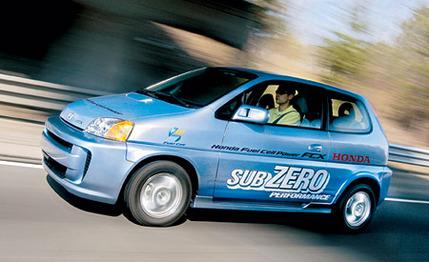
 Road Test
Road Test
Hydrogen as a source of fuel to power cars is all the hype these days. Automakers are investing hundreds of millions developing hydrogen fuel cells, and American taxpayers are contributing as part of a $1.8 billion 10-year federal grant to underwrite research. It seems you can hardly get through a newspaper these days without reading about these "cars that don't pollute." Although it's true that what comes out the tailpipe of a fuel-cell vehicle is plain ol' water, getting the hydrogen into the tank is hardly a pollution-free task.
Many advocates of fuel cells often suggest electrolysis-producing hydrogen from water using electricity-as one process that could reduce our dependence on fossil fuel. But in all the fuss over hydrogen, what's being overlooked is the fact that it takes about 20 percent more energy to drive a mile on hydrogen produced by electrolysis than on gasoline. And although a fuel cell itself produces no greenhouse gases (carbon dioxide, oxides of nitrogen), the process of producing hydrogen via electrolysis releases roughly 24 percent more of these gases than producing and burning gasoline in a vehicle. Some suggest generating this huge amount of electricity in a pollution-free fashion-using solar cells, for example-but it's far too costly for now.
However, most hydrogen today is produced from natural gas via a process that is about 60-percent energy efficient (compared with 80 percent for gasoline refining). But since fuel cells powering electric motors are much more efficient than gasoline-powered engines, their overall efficiency is about 10 percent better-and they also produce about 45 percent fewer greenhouse gases. However, if all cars were powered by cells fueled by hydrogen from natural gas, overall natural-gas consumption would increase by 66 percent. And most of that natural gas is sitting underground in the Middle East.
Even so, Honda is proceeding with the development of fuel-cell-powered cars, and in fact, this FCX is the fifth version-the first one was introduced in 1999. The reason you don't see them on the road is they're produced in tiny batches and not sold to the public. Its exterior size and shape have remained constant while many improvements have been made to the fuel-cell powertrain. The current hydrogen Honda is 63 percent more powerful than the 1999 version, and the size of the fuel-cell stack-the powerplant itself-has been cut in half. The previous-generation FCX was powered by fuel cells manufactured by Ballard Power Systems, but this latest fuel-cell stack was developed in-house.
A fuel cell brings together hydrogen gas (in this case compressed in the FCX's two tanks at 5000 psi) and oxygen from the air to create electricity. The byproduct of this process is water, which is sent dribbling out the tailpipe. The energy is used to directly power an electric motor that is connected to the front wheels. One of the problems with fuel cells is lousy throttle response, caused by an inability to increase electrical output quickly enough. An "ultra-capacitor" deals with this problem by supplementing the electrical requirements when needed.
Think of this ultra-capacitor as a battery, except that a battery undergoes a chemical reaction during charge and discharge, which makes it less efficient than the ultra-capacitor. Capacitors are measured in farads, and this one is rated at 9.2 f. As capacitors go, it is huge, but a typical gasoline-electric hybrid vehicle has two to three times as much energy available to assist with acceleration.
The FCX is similar in size to a Civic Si hatchback-about two inches shorter, but 2.6 inches wider and a whopping 8.1 inches taller. It weighs a hefty 3692 pounds, which is 952 more than the Civic. However, a benefit of having the fuel-cell components spread out [see diagram] is a weight distribution of 54.5/45.5 front to rear, which is more balanced than that of a typical front-driver.
Plus:
Three Days, Three Full Tanks